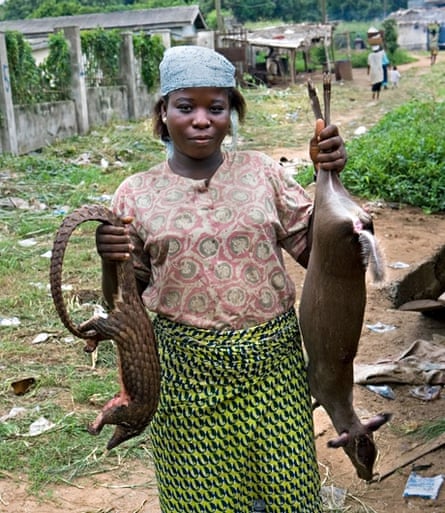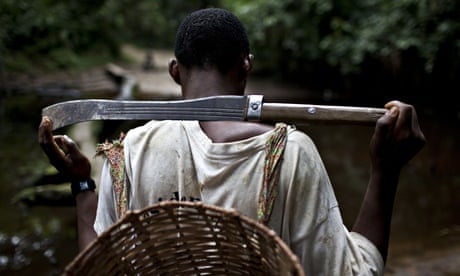As I rattle across the Welsh countryside in an early morning train, a verdant landscape bounces into view. A blurred jumble of grass, trees, brambles and bushes flies past the window. Catching a lift from Carmarthen station through the Towy valley to the National Botanic Garden of Wales, an even more staggering array of plant life shows itself resplendent. A few I recognise – the heavy boughs of an oak – but most I don't. To me it's just one big, leafy, glorious green vision. Everything looks the same.
But it isn't. As Dr Natasha de Vere, head of conservation and research at the garden, tells me when I arrive that Wales is home to 1,143 native flowering plant and conifer species. And she should know: she has led a team to document each and every one of them using a new approach that could not only revolutionise our ability to label our world, but also help law enforcers clamp down on crimes ranging from seafood fraud to wildlife trafficking.
Taxonomy may have kicked off in earnest with Carl Linnaeus more than 250 years ago, but it didn't end with him: cutting-edge techniques from the burgeoning field of molecular biology are offering fresh approaches to identification. Using them, De Vere and her team of researchers have catalogued the entire native flora of Wales and now, with colleagues at the Royal Botanic Garden Edinburgh, they are extending the resource to cover the whole UK. Its basis? Just two tiny regions of DNA.
Known as "DNA barcodes", these short sections of genetic material allow researchers to identify a species, even when traditional methods such as examining leaf shape or flower parts come a cropper. "Where barcoding really comes into its own is if you want to tell what something is and you have only got a fragment: a single bit of root or even a single pollen grain," says De Vere. "The whole point of DNA barcoding is identification – it is being able to say this is this species, this is that – and the applications that arise from knowing that."
The brainchild of Canadian scientist Paul Hebert, DNA barcoding burst on to the scene in 2003. At its heart is an elegant premise – some ubiquitous regions of DNA have evolved differences in the sequence of their building blocks (called nucleotides) at just the right rate to prove valuable for species identification. "You want a bit of DNA which is conserved but just has a little bit of variation between species," says De Vere. "You don't want variation within the species, or else it is too complicated."
In animals, the short stretch of DNA that satisfies this – and other key criteria, such as the ability to be easily copied or "amplified" in the laboratory – is known as cytochrome C oxidase 1 (COI). Just 648 base-pairs long, it is found in rings of genetic material within mitochondria – the energy-generating powerhouses of the cell. In plants, the DNA that does the trick is typically taken from chloroplasts – the cell machinery, derived from organelles called proplastids, that turns carbon dioxide and water into sugar and oxygen. DNA from chloroplasts and mitochondria also keeps it simple: unlike nuclear DNA, it comes from just one parent, as these cellular components are inherited from only one parent. Unsurprisingly, the plant-derived barcode regions have also been given snappy little monikers and are referred to by those in the know as matK and rbcL. "RbcL is really conserved because it needs to be used in photosynthesis," says De Vere.
Putting the power of barcoding in perspective, it is estimated that it is possible to tell apart up to 75% of plant species in the whole of Wales using the rbcL and matK barcodes. Shrink this to an area of just 2 sq km and it is possible to distinguish 93% of species.
It took four years for De Vere and her team to build a reference library containing barcodes for the entire native plant life of Wales. It was the first nation to boast such a resource, completed in 2012. But the work built on decades of collecting by amateur enthusiasts and professional scientists alike; the majority of samples came from neatly pressed herbarium vouchers tucked away in the National Museum of Wales. With multiple specimens required for each species, every voucher was verified by the museum's expert plant taxonomist Dr Tim Rich, before a tiny snippet was removed and its DNA extracted in the lab. Thanks to a process known as PCR (polymerase chain reaction), the barcode region of DNA was amplified and its nucleotide sequence determined. The upshot: a digital DNA catalogue of Welsh flora. And, with the data uploaded on to international reference libraries, it's available to anyone. That, says De Vere, is vital: "The key thing is that people start to use that information."
In her own research group, work is progressing on pollen. While pollen doesn't contain chloroplasts, it does contain starch-storing proplastids that bear the DNA necessary for barcoding. By analysing the barcodes from pollen, De Vere and her team hope to provide new insights into a host of biological intrigues, from elucidating the link between plant species and hay fever, to mapping the movements of pollinators such as hoverflies and bees.

Poring over a computer screen in the adjacent laboratory office, PhD student Jenny Hawkins is stuck into another promising avenue of research, the medicinal properties of honey. Manuka, made by bees in New Zealand who harvest their loot from the tea tree, is famed for its antibacterial properties. Hawkins is looking for a UK equivalent, and she's doing it with barcodes. By systematically eliminating the effects of ubiquitous components, her goal is to find correlations between the honey's ability to kill off the hospital-bug MRSA and the plants from which the honey is made – as indicated by the pollen trapped in the sample. But it's early days, and the barcode data doesn't necessarily tell the whole story. "It's semi-quantitative at best," says De Vere. "There's lots of little biases in terms of what's amplified, what's extracted." However she believes the early results show the theory has legs. "This is the very beginning of what could be an incredibly long process, but it is a starting hypothesis."
With so many potential applications, it might seem like DNA barcoding is the silver bullet of taxonomy. But while many agree that it is a useful tool for matching samples to species that have already been discovered, its broader value is hotly debated. "Let's assume you went to an art museum and you assigned a unique barcode to each painting so you could accurately identify it, but you put the barcode on the back and then you hung all the pictures facing the wall," says taxonomist Quentin Wheeler from Arizona State University. "You could walk through that gallery and accurately identify every picture, but is that the reason you go to an art gallery? It's the same in nature: DNA barcoding only offers us the way to identify species and know absolutely nothing about them that makes them worth knowing in the first place."
And when it comes to discovering a new species (there are an estimated 10 million yet to be found) the waters get even muddier. "[Barcoding] is kind of a blunt instrument for confronting that level of biodiversity," Wheeler says. "What you do is look at the average genetic distance between known species and then assume that any unknown ones are going to differ by the same or larger amount. That may or may not be true, but it is more of a self-fulfilling prophecy than it is science." But in spite of such concerns, barcoding has found itself a niche. "Having a way to verify that species being traded in are what they claim to be is an ideal application."
Steaming ahead to do just that, De Vere is one of a team of scientists using DNA barcodes to crack down on wildlife trafficking. "As something goes on to the red list, [collectors] want it, and people go to huge lengths to own these things," she says. And in attempting to outfox the authorities, poachers and traffickers are becoming masters of disguise. "They know that expert taxonomists can identify things based on certain diagnostic characters – they want to mask that," Dr David Schindel says. "Smugglers will pluck the feathers off a parrot, put it in a plastic tube and ship it, live, to its destination where it's taken out and it will regrow the feathers. Plants can be exported as rootlets, as seeds, as leaf cuttings." His conclusion is blunt. "We are caught in an arms race."
As executive secretary of the Consortium for the Barcode of Life, based at the Smithsonian Institution's National Museum of Natural History, Schindel is leading a team to agree standards and promote the use of barcoding. He believes it could be a secret weapon for law enforcers, providing salient information without requiring extensive resources. "The data that's generated by whole genome sequencing carries with it a tremendous overhead in terms of the computing power and the expertise in bioinformatics to interpret that," Schindel says. "So when you are looking for a species identification, that really is a case of shooting off a cannon to kill a fly."
It seems the big guns agree. One of five proposals by Schindel to demonstrate the power of DNA barcoding, the Barcode of Wildlife project caught the eye of Google, which invited him to apply for $3m funding from its new Global Impact Awards scheme. That was in 2012, and since the funding was secured, progress has been brisk. Focusing on six countries, the project already has South Africa, Kenya, Nigeria and Mexico on board, while Nepal and a South American country are due to get started imminently. Each has two years' worth of support and the first task is the creation of a list of 200 priority species. "The next phase is getting all the training done and that is what we have just started," De Vere says. Using samples taken from museum records, zoos and botanical gardens, the team will create detailed records with DNA barcodes, not only for illegally traded species, but also for those closely related or bearing a striking resemblance. But this is no academic escapade; it is a working pilot scheme. "We want to develop a database not just for research but one that will stand up in court," Schindel says.
Unlike genetic profiling, DNA barcoding cannot identify individuals or determine which population a specimen came from, but it doesn't need to. "In most countries it doesn't matter where an animal was killed for an arrest to be made; if it belongs to a particular species that's protected by that country it's a crime to possess it," Schindel says. "If you are caught with a parrot in Mexico, you are in trouble. So we call that the Mexican parrot rule," he grins.
Not every illegally traded item needs to be sent to a forensic lab to determine what it is – there's not much mystery to an elephant tusk – but for other specimens, DNA barcodes could be crucial in unravelling identity. "If you intercept a box of capsules of medicinal plants at the border, how do you know what's really in them?" Schindel says. "Is it what it's labelled or could it be an endangered species?" Different countries have different priorities: Mexico has a thriving illegal trade in reptiles while Kenya and Nigeria are aiming to tackle the trafficking of bushmeat. "When those meats are trafficked into other countries, that's not just illegal, it is a health hazard. We are finding infectious viruses in them. In west Africa now there is an outright ban in some countries because they found Ebola in the bushmeat trade."

Comments (…)
Sign in or create your Guardian account to join the discussion